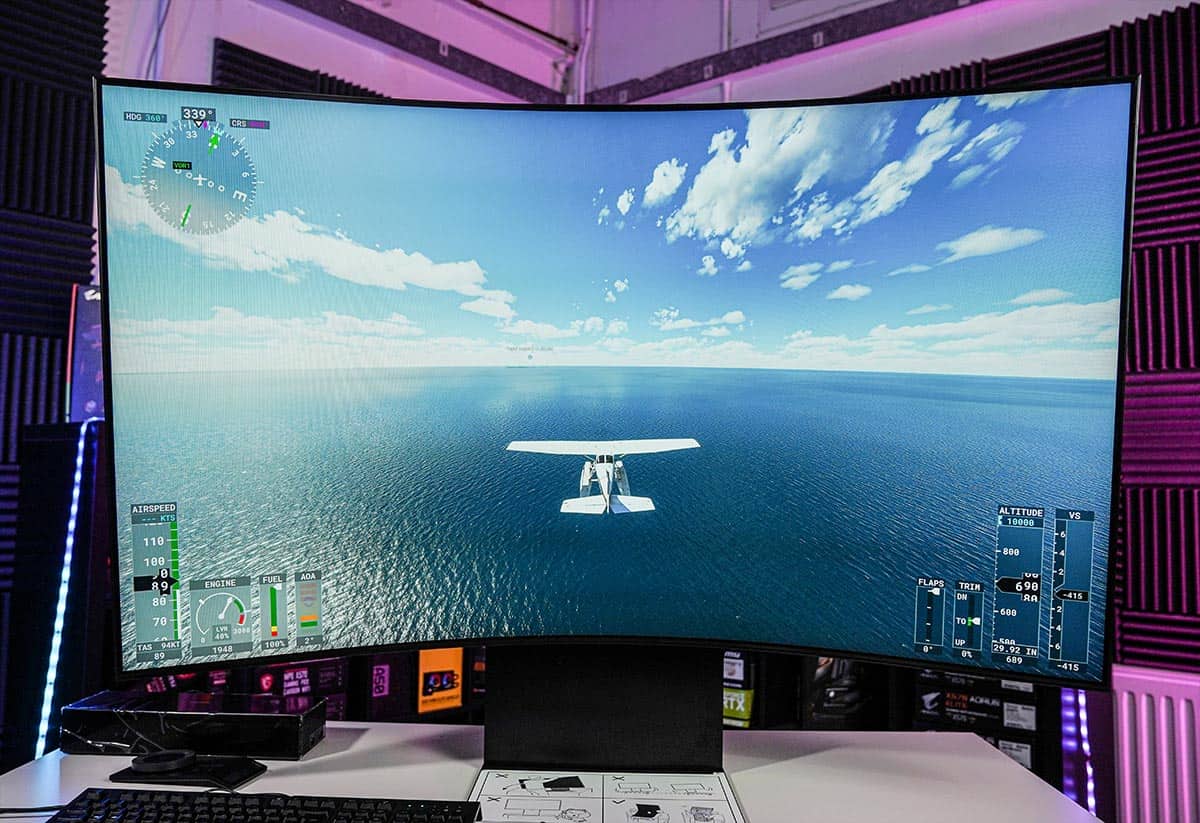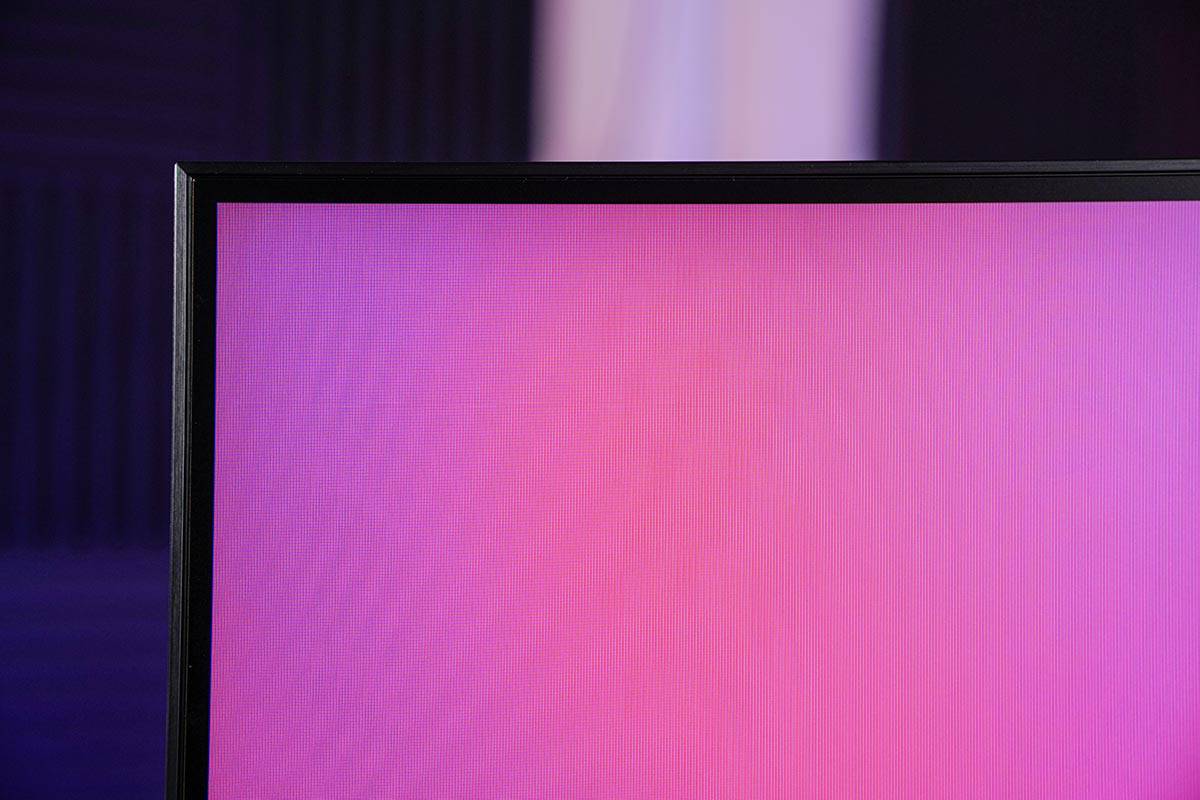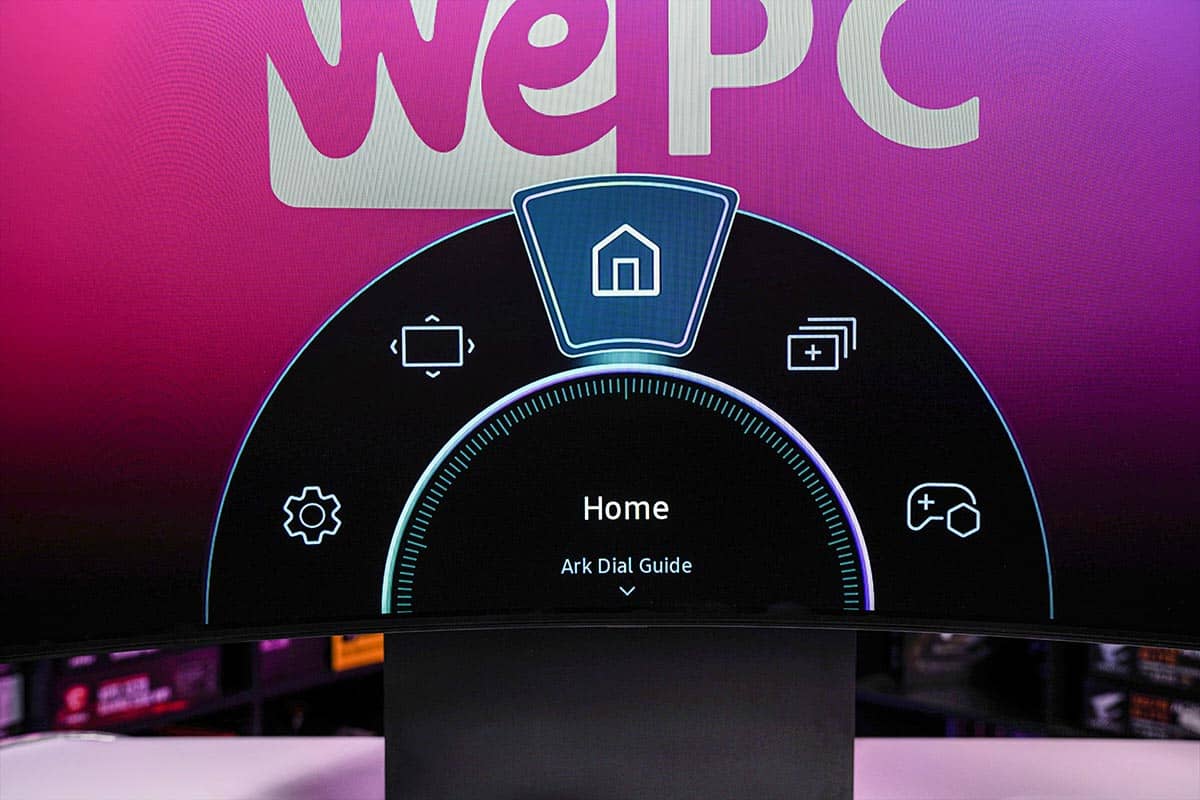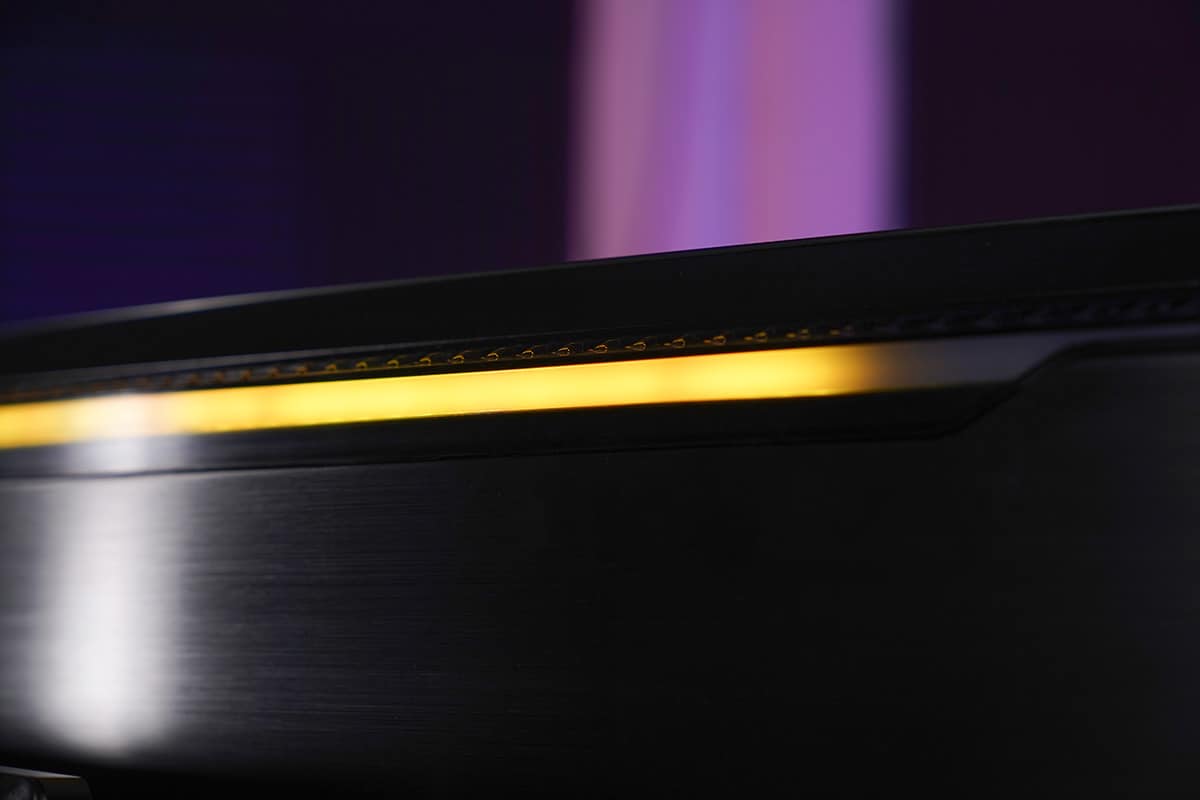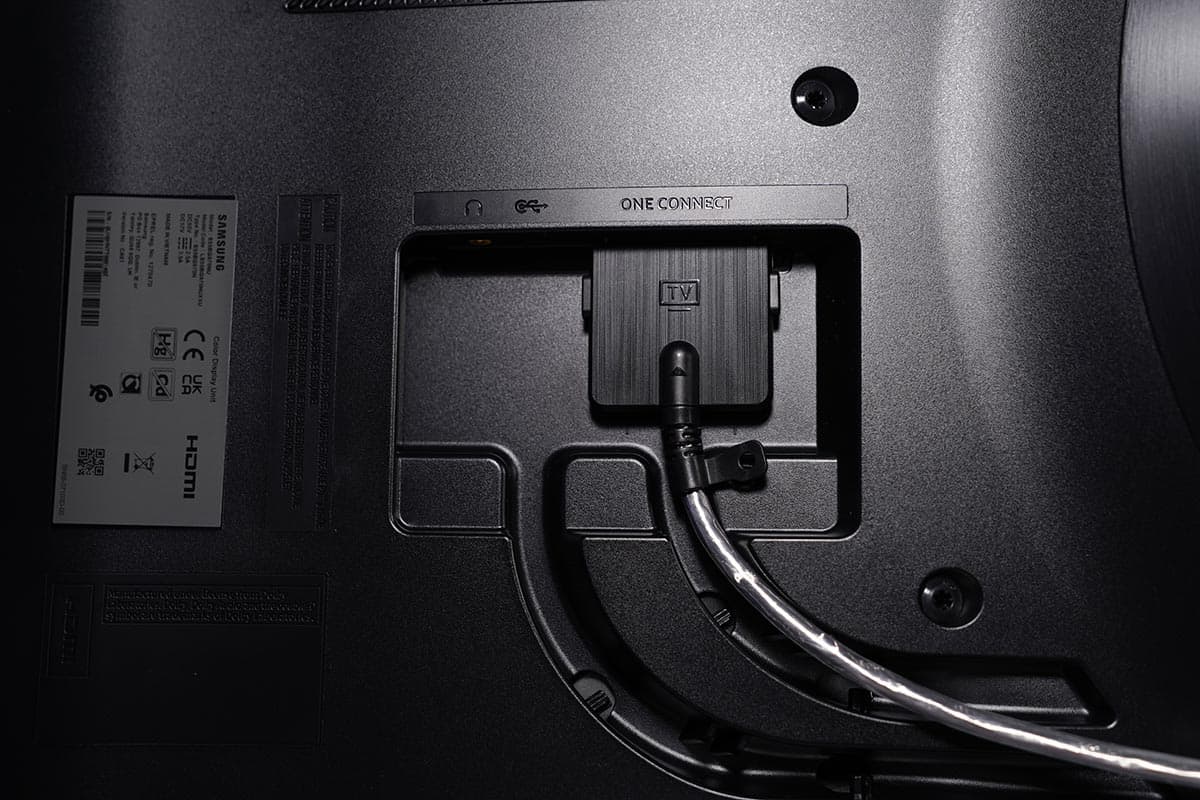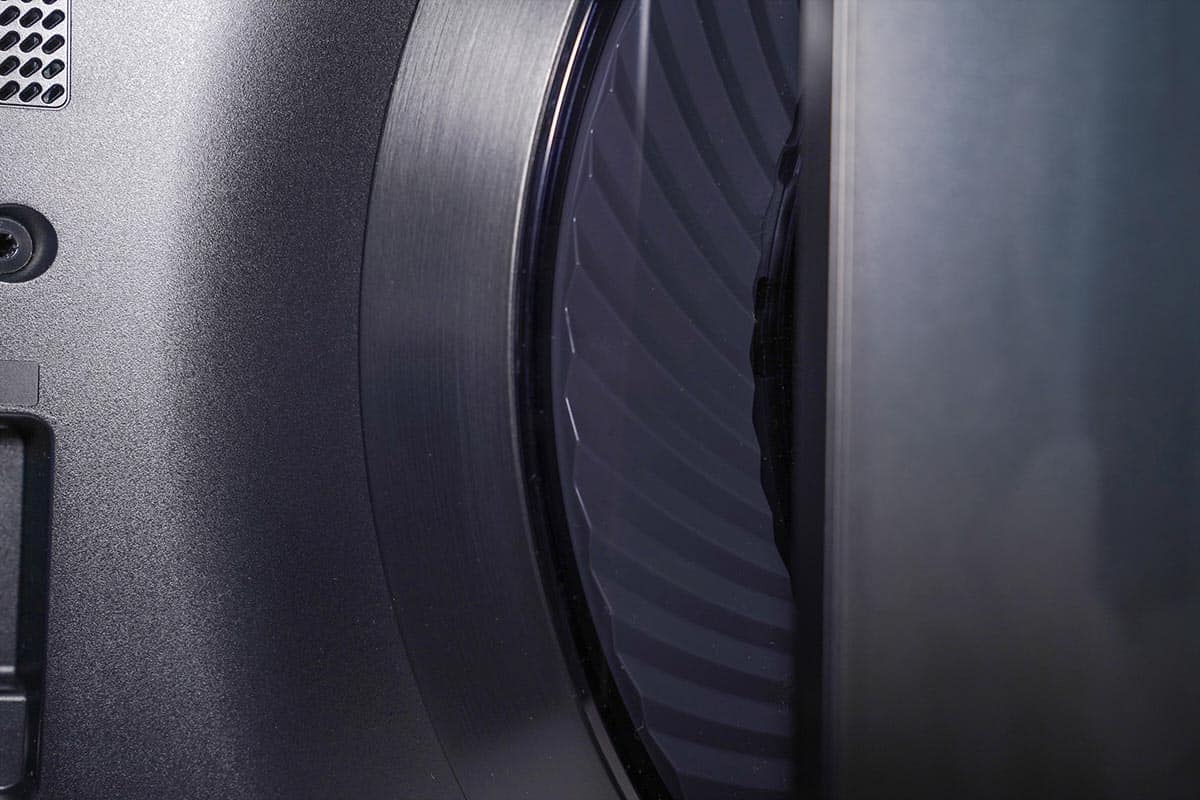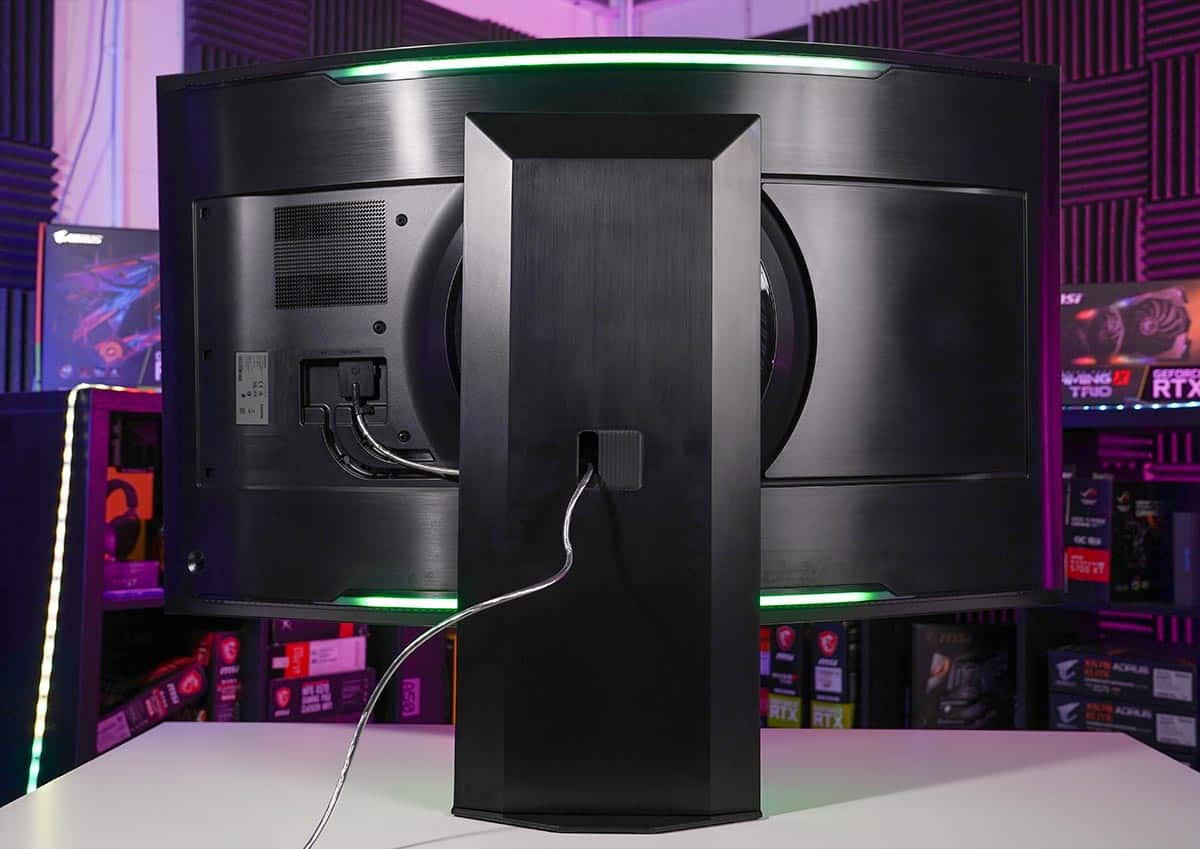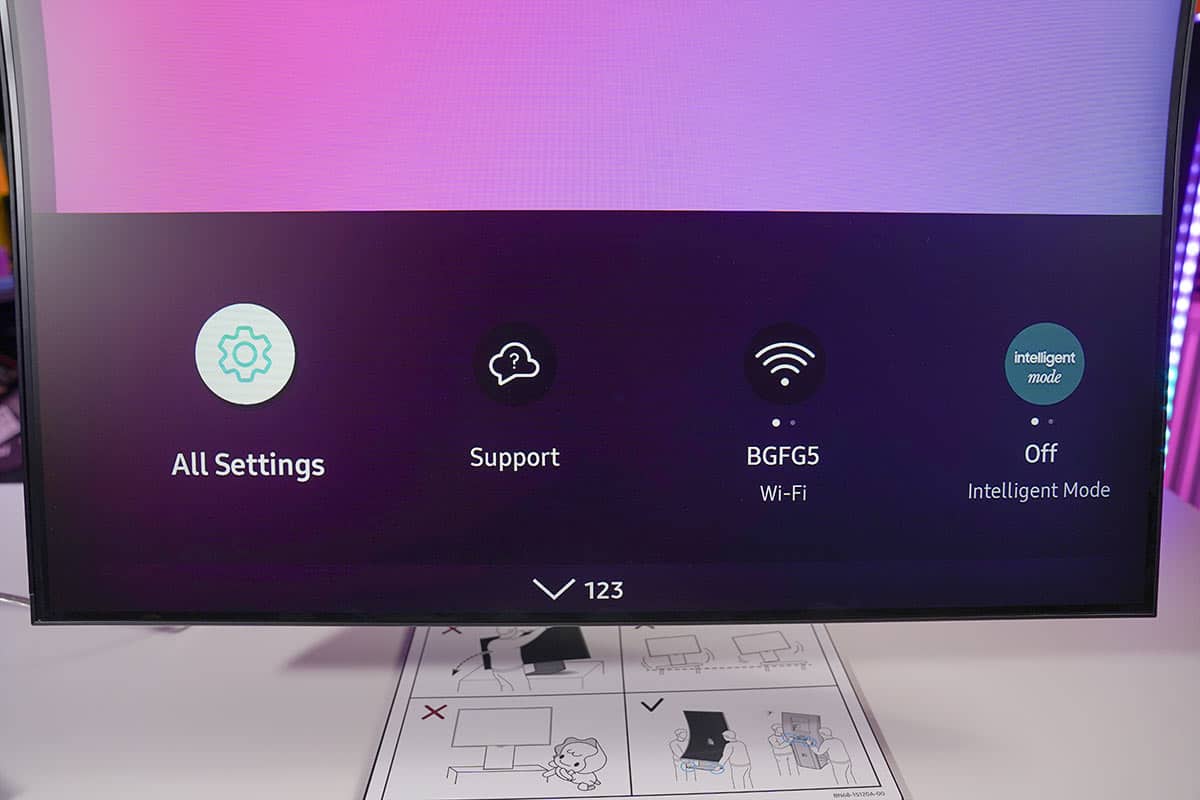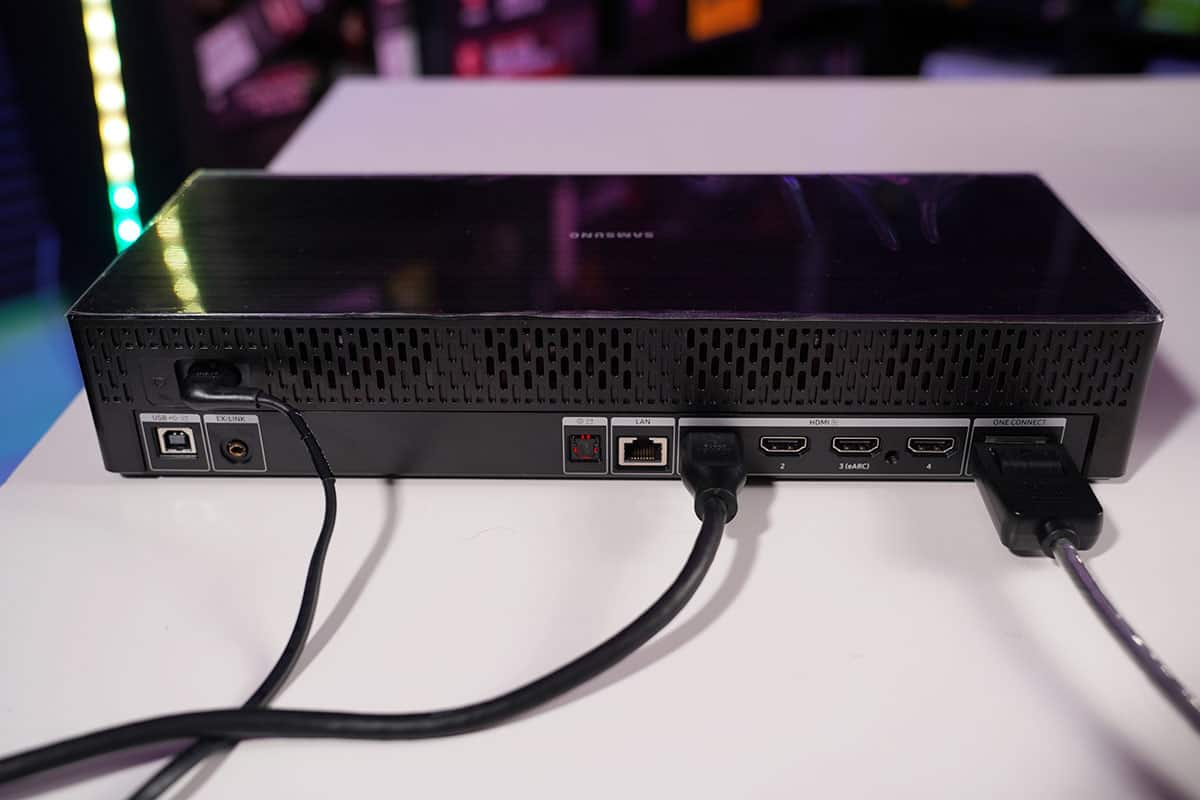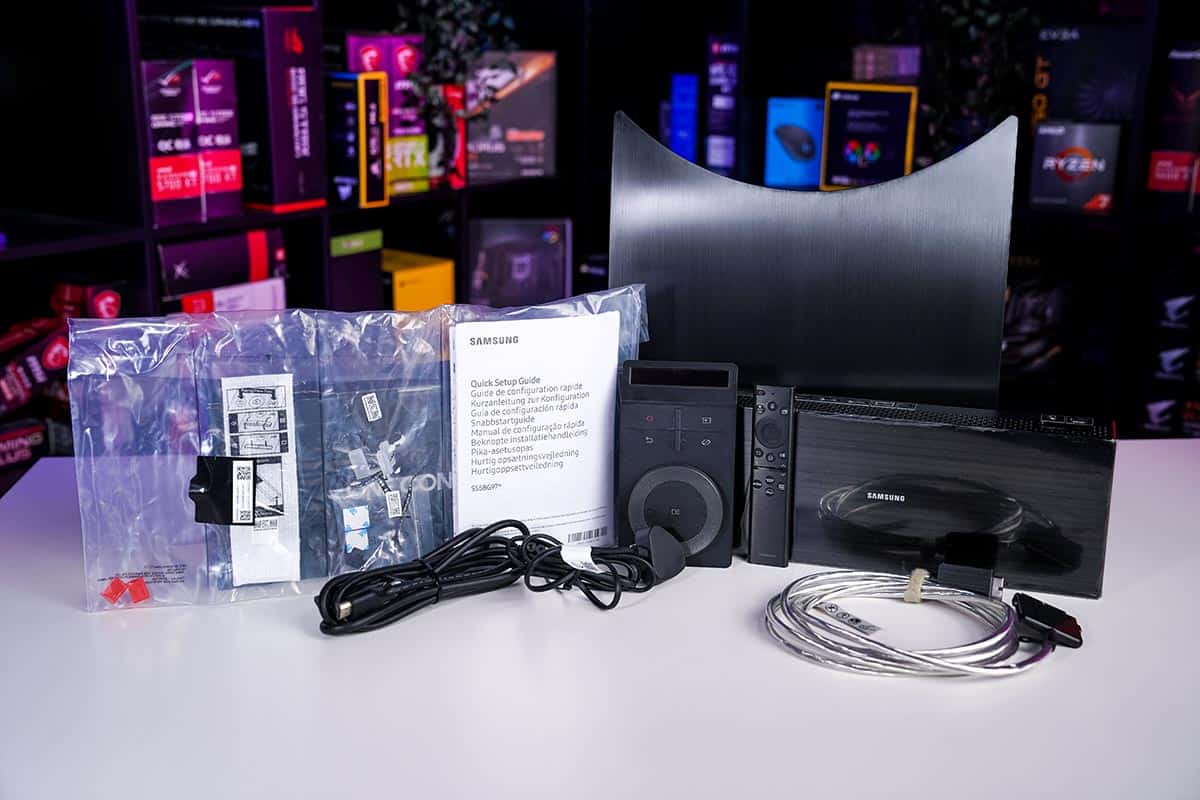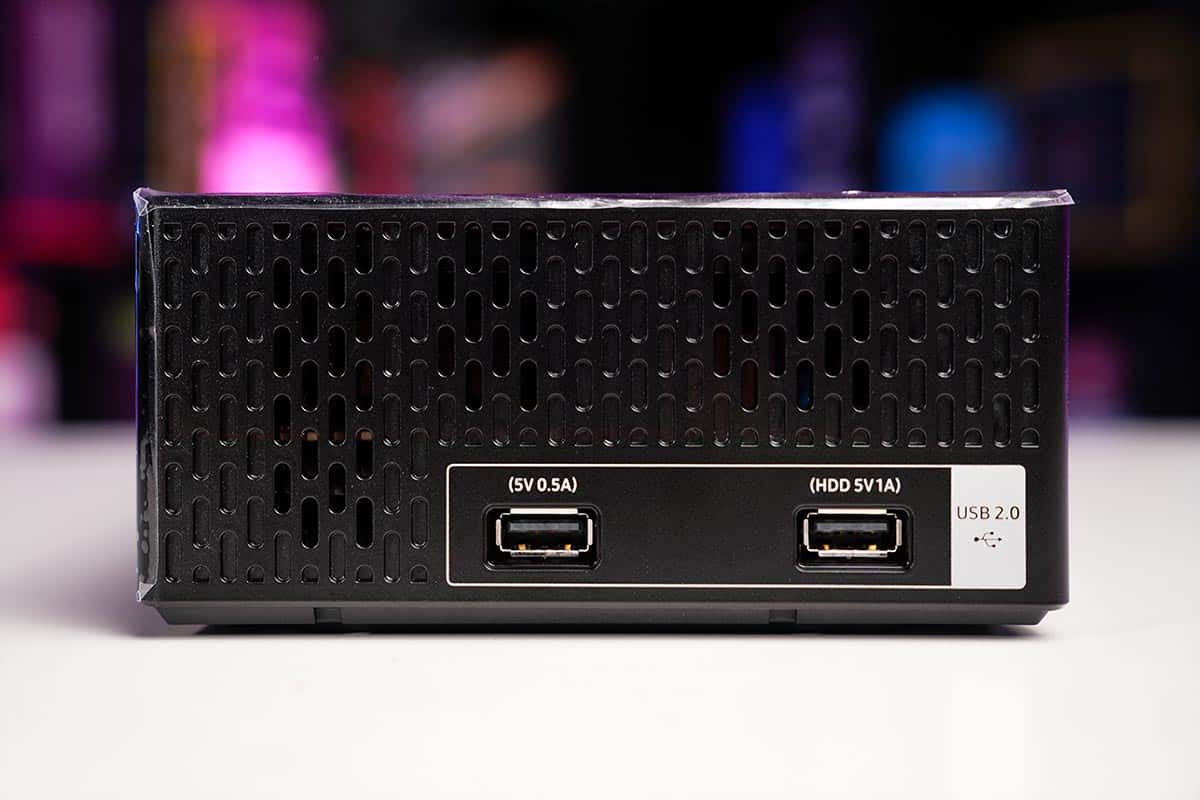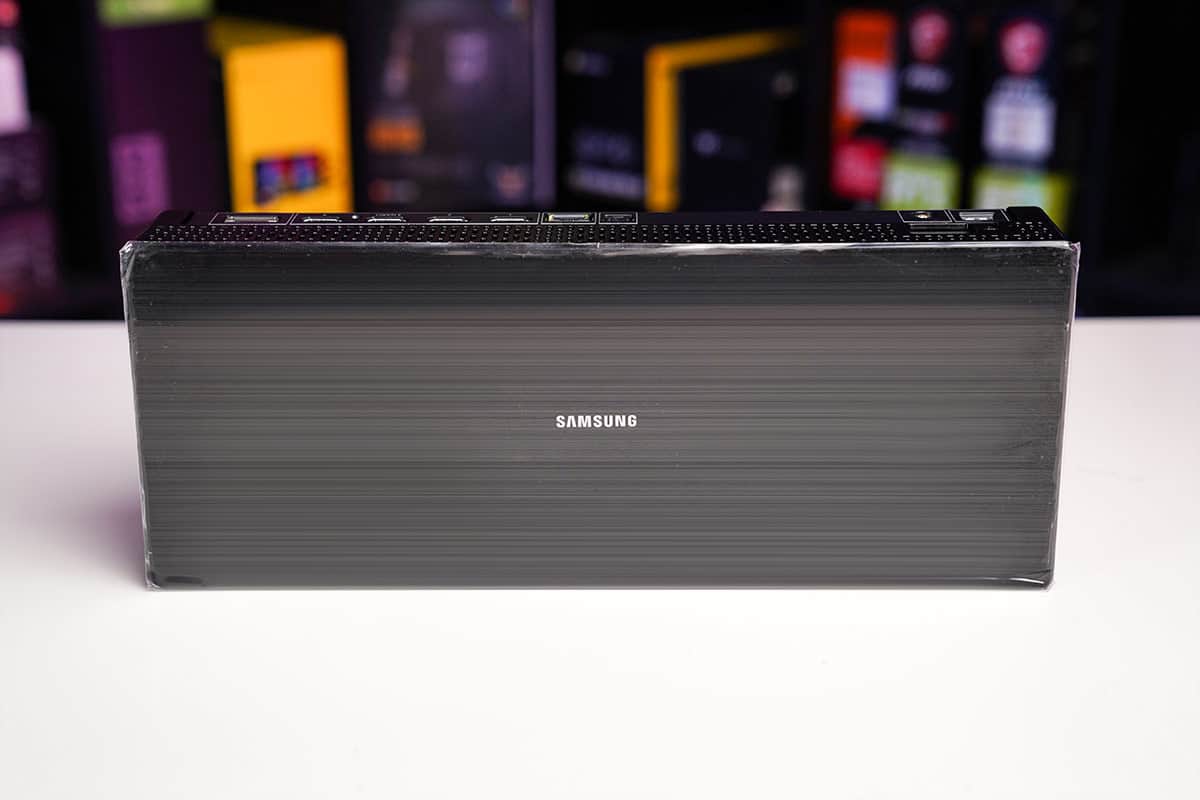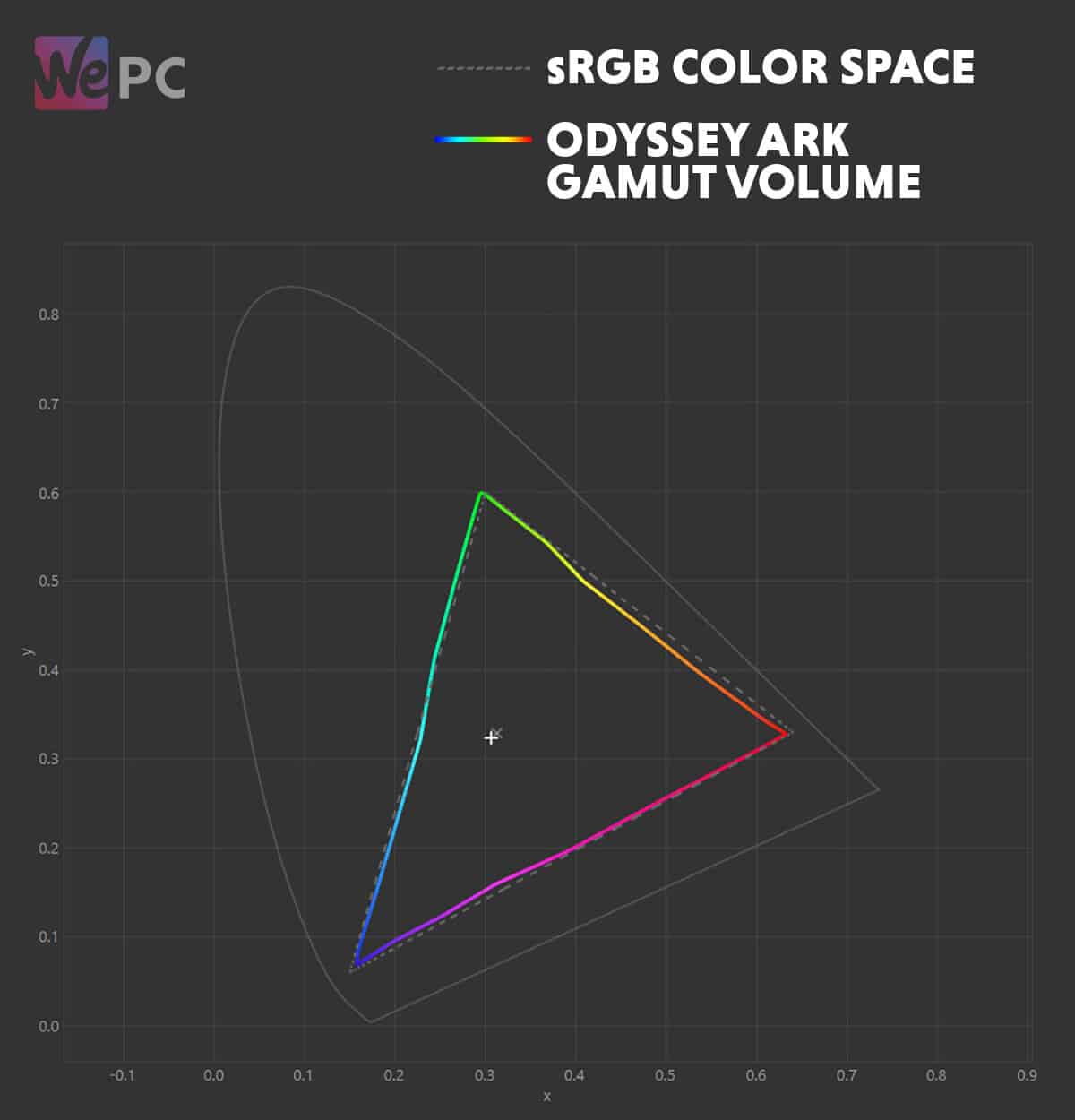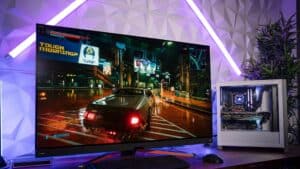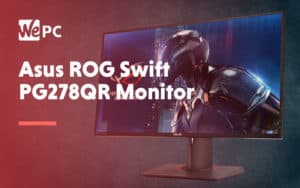Samsung Odyssey Ark Monitor Review
The new god of gaming monitors has arrived - but is it actually practical?
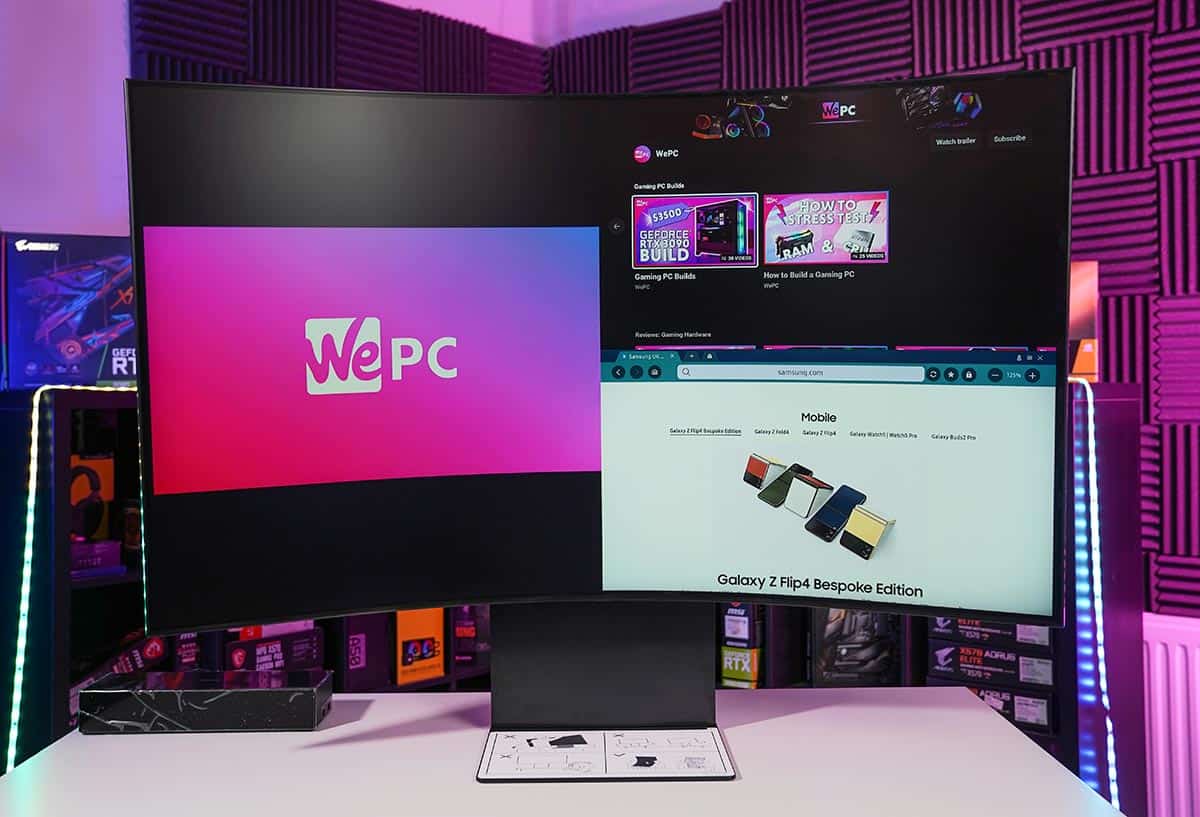
WePC is reader-supported. When you buy through links on our site, we may earn an affiliate commission. Prices subject to change. Learn more
The Samsung Odyssey Ark gaming monitor is by far one of the most audacious arrivals we’ve had in the WePC testing studio in some time.
The behemoth gaming monitor is being described by Samsung as the perfect gaming theatre – ideal for serious gaming, productivity, and streaming. At its core, the Samsung Ark comes equipped with a massive 55-inch UHD 4K display, 165Hz refresh rate, and all the gaming features you could shake a stick at.
It also features a number of HDMI 2.1 ports too (no DisplayPorts), meaning the Ark will support next-gen console gaming at 120Hz – alongside Quantum HDR 2000 and mini LED backlight technology (boasting 1,056 local dimming zones).
On the surface, this seems like the sort of bizarre monitor that a child would think up when high on pure display euphoria. But that isn’t the case.
This monitor is said to have real-world use cases – and we’ve spent the last few days trying to figure out exactly what those are.
In this guide, we’ll be reviewing the Samsung Odyssey Ark monitor in full – testing the display for color accuracy, gaming performance, build quality, and overall functionality – putting some of the panel’s main features and buying points to the test.
So, will the Samsung Odyssey Ark ignite our visual senses? Or will it be crowned the most pointless monitor of 2022?
Let’s find out.
Samsung Odyssey Ark specifications
Samsung Odyssey Ark gaming monitor

Refresh Rate
165Hz
Response time
1ms
Screen size
55″ display
Resolution
3840 x 2160
Refresh Rate
165Hz
Response time
1ms
Screen size
55″ display
Resolution
3840 x 2160
Aspect ratio
16:9
Panel type
VA
Brightness
600 cd/㎡
Contrast ratio
1,000,000:1 (Static)
Color Depth
10 bits
Viewing angle
178/178
Color Gamut
95% DCI-P3
Backlight technology
Mini LED (1,056 zones)
Panel Coating
Anti Glare (in matte)
Curvature
Curved 1000R
VESA
N/A
- 55-inch 1000R curve
- 165Hz refresh rate
- Incredible image quality
- Impressive speaker system
- Fully supports next-gen consoles
- Quantum HDR 2000 certification
- Mini LED backlight technology (1,056 zones)
- Incredibly expensive
- Heavy design that is hard to move
What’s In The Box
The Samsung Odyssey Ark arrives in a giant box that showcases some of the panel’s main features and some marketing material on the exterior.
Inside, the monitor is packaged in a TV-esque orientation – stood up next to the stand. Users will require another individual to construct this monitor as it weighs 100lbs (41.5KG).
Construction of this monitor does require a screwdriver to secure the stand into the rear of the panel. Additionally, the base of the stand has four screws that need to be tightened as well.
Overall, this is a pretty difficult monitor to construct – mainly due to its sheer weight.
Alongside the panel and the stand, users will find the following items:
Samsung Odyssey Ark gaming monitor

Refresh Rate
165Hz
Response time
1ms
Screen size
55″ display
Resolution
3840 x 2160
Design And Features
With specifications out the way, let’s take a closer look at the build quality, design, and mechanical features the Samsung Odyssey Ark comes equipped with.
Aesthetic design
The Samsung Ark is by far one of the biggest monitors we’ve tested – but that’s not what makes this thing so unusual. It’s the fact that this 55-inch monitor can be rotated into a portrait orientation, making it look (and feel) absolutely gigantic, and, honestly a bit intimidating.

The swooping 1000R curve seems to go on forever – accompanied by super-thin bezels on all four sides that help achieve a stylish and premium profile. That same curve also creates the basis for the incredibly immersive viewing experience that makes up the crux of its USP. This makes it bespoke for playing Xbox or watching movies (something we’ll discuss in further detail shortly).

The base of this monitor is absolutely massive and weighs more than the display itself. It features a large square footprint that, despite its size, does actually work with the monitor’s futuristic styling.

The “neck” of the stand is also massive, featuring a brushed aluminum finish that fits in nicely with the rest of the monitor’s aesthetic theme. In fact, the stand itself resembles the monolith from 2001: A Space Odyssey, stuck to what looks like a giant curved fragment of some kind of enormous spacecraft. There’s not a lot going on in terms of details, but there’s a whole lot of surface area to um, appreciate.
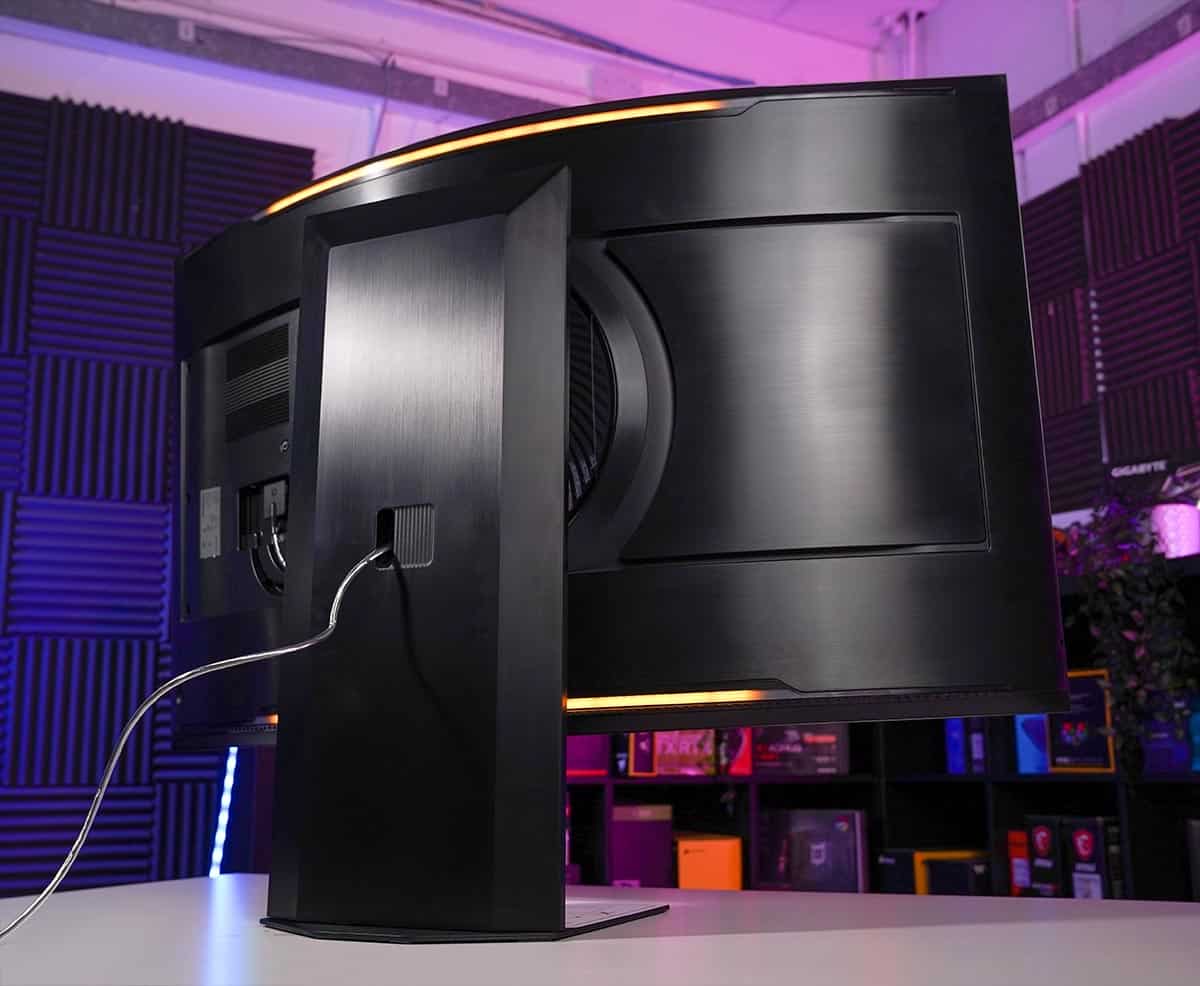
More brushed aluminum plastic has been used at the rear of the panel, with two large LED lighting zones on the top and bottom (depending on what orientation you’re using it in). All lighting can be altered within the monitor’s OSD.
Build Quality
The Samsung Ark weighs in at an impressive 100lbs (41.5KG) – meaning build quality should be of the utmost importance. Luckily, it seems like Samsung has prioritized build materials and construction in the manufacturing process of this monitor.

Upon unboxing, we can confidently say that this monitor feels absolutely rock solid. The stand by itself weighs almost 50lbs of pure metal, meaning that maneuvering the panel around can be almost impossible. That said, the stand has to be this robust just to maintain some level of stability.
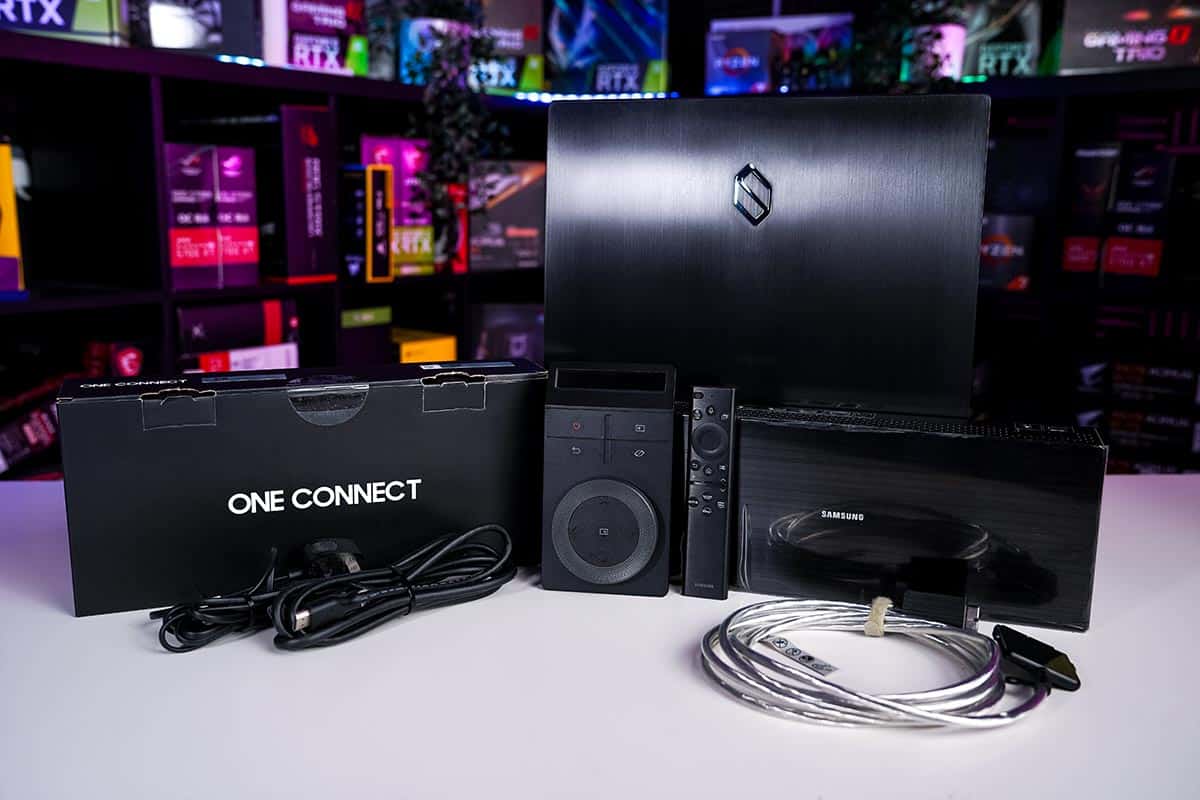
The display itself clips into the back of the stand via a toolless design, with two screws available for securing it in place. Once secured, the monitor does experience a little bit of wobble but nothing that’s too offputting.
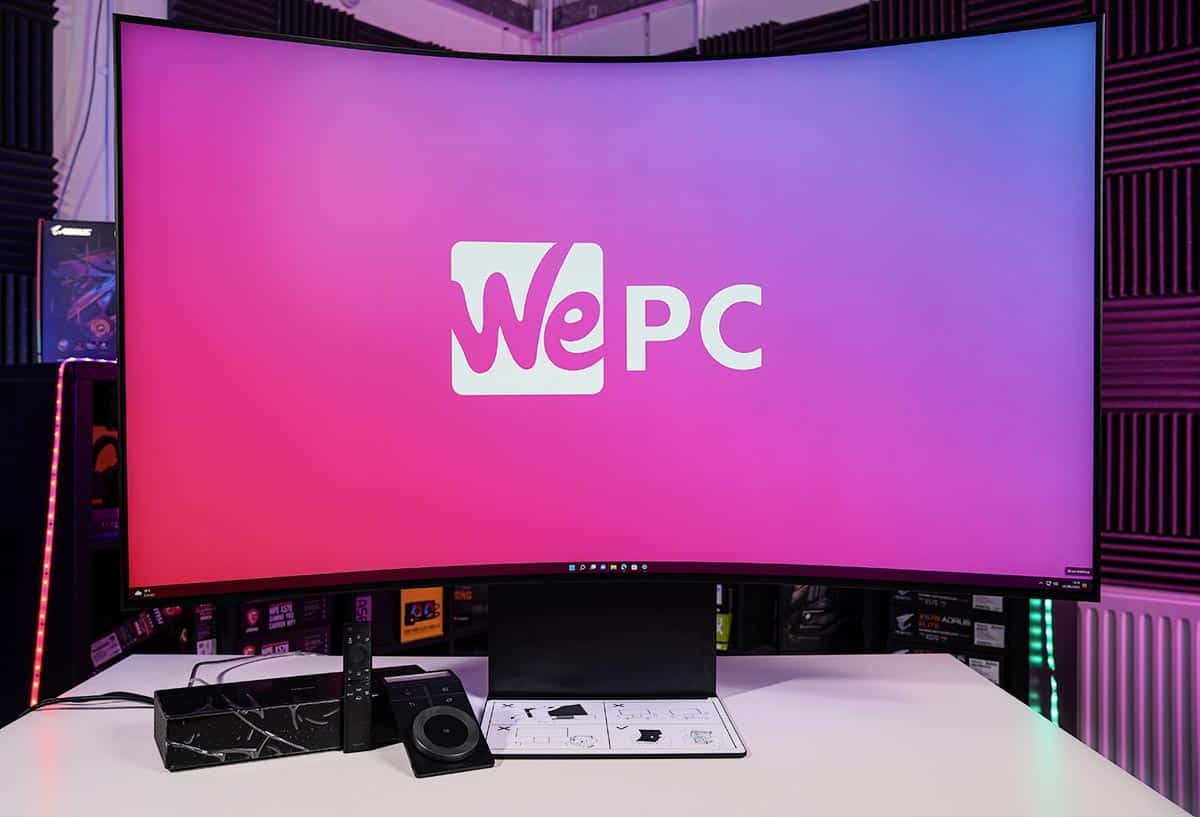
Having said that, any wobble whatsoever when you’re sitting in front of this monitor can feel incredibly intimidating – especially when it’s in the portrait orientation.
All fittings and fixtures on the rear of the panel also feel incredibly well-finished, with the Samsung “One Connect” box also providing a level of luxury that you don’t normally get with generic power bricks.
Ultimately, it feels like Samsung has taken the necessary steps during the manufacturing process to ensure this monitor is stable during usage.
Panel Coating
Like many modern monitors, the Samsung Odyssey Ark features an anti-glare matte coating that helps to mitigate and absorb natural light to reduce reflective artifacts.
The coating does a fine job at absorbing light reflections, however, due to its massive curved nature, there are still blooms of reflectivity during usage.
Additionally, with the Samsung Ark offering landscape and portrait modes, it will likely pick up a tonne of fingerprints during usage.
Bezels
Despite its massive size, the Ark still comes with incredibly small bezels that help to add to the immersion when gaming, or during general content consumption.
The top and side bezels measure in at an incredibly respectable 9mm while the bottom bezel features a larger 12mm bezel (still much smaller than many of today’s gaming monitors).
Stand
The monolithic feature that Samsung has called a stand is both robust and versatile.
One of the main features of this panel is its ability to utilize both landscape and portrait modes – with automatic mode changes enabling between rotations.
Aside from full 90-degree pivot functionality, the stand also features tilt and height adjustment too.
Below are the full adjustments available with this particular panel:
Landscape mode:
- Forward Tilt – 10 degrees
- Backward Tilt – 10 degrees
- Left Swivel – Unavailable
- Right Swivel – Unavailable
- Pivot – 90 degrees
- Height – 270mm
Portrait mode:
- Forward Tilt – 13 degrees
- Backward Tilt – 10 degrees
- Left Swivel – Unavailable
- Right Swivel – Unavailable
- Pivot – 90 degrees
- Height – 30mm
Samsung Odyssey Ark gaming monitor

Refresh Rate
165Hz
Response time
1ms
Screen size
55″ display
Resolution
3840 x 2160
Inputs
Unlike smaller gaming monitors, the Samsung Ark makes use of an input dock that isn’t physically attached to the monitor itself.
The dock has been coine d the “One Connect” and acts as the main input source and the power brick – connecting to the power and your unique devices.

The input dock features 4 x HDMI 2.1 ports (one of which supports eARC), a 3.5mm EX-Link headphone jack, Ethernet port, and optical input – meaning you’ll be able to hook up four devices simultaneously, alongside a soundbar too.
The Samsung Ark also offers enough bandwidth to support 4K gameplay at 165Hz – via any of the available HDMI 2.1 ports available.
Unfortunately, no DisplayPort cable is available on the Ark.
OSD
Users can control the OSD with the remote or the futurstic-looking Ark dial that is unique to this panel.
Despite this display being classed as a gaming monitor, the OSD certainly looks more like something you’d see on a TV. That said, it still features all the relevant picture and color enhancements you’d expect from a gaming display.
Alongside this, users can also fine-tune the audible experience of this monitor – with custom presets available for a more rounded sound.
A comprehensive game menu (called the Game Bar) has also been added to this display, allowing you to customize the pixel response time, VRR, aspect ratio, and other settings of the Samsung Ark’s gaming performance.
Additionally, Microsoft’s Xbox Game Pass is built into the display itself, meaning you’ll be able to access your entire Xbox library through the Samsung Ark.
Let’s not forget the multi-view functionality either. Samsung has added this feature to allow users to split the display into four separate sources.
While this sounds great on the surface, the options are limited for this feature – with only 1 HDMI input available at a time. That means you will not be able to split your screen into three or four segments and use two HDMI inputs at the same time.
Right now, the Multi-View feature seems a little pointless – especially when you factor in Window’s own snapping tool.
Samsung Ark Dial
The Ark comes with a remote control – the same used on Samsung TVs – and a cool looking dial for OSD navigation.
The Dial will be most people’s favoured option for navigating the various menus, offering a hyper-futuristic feel to this already unique looking panel.
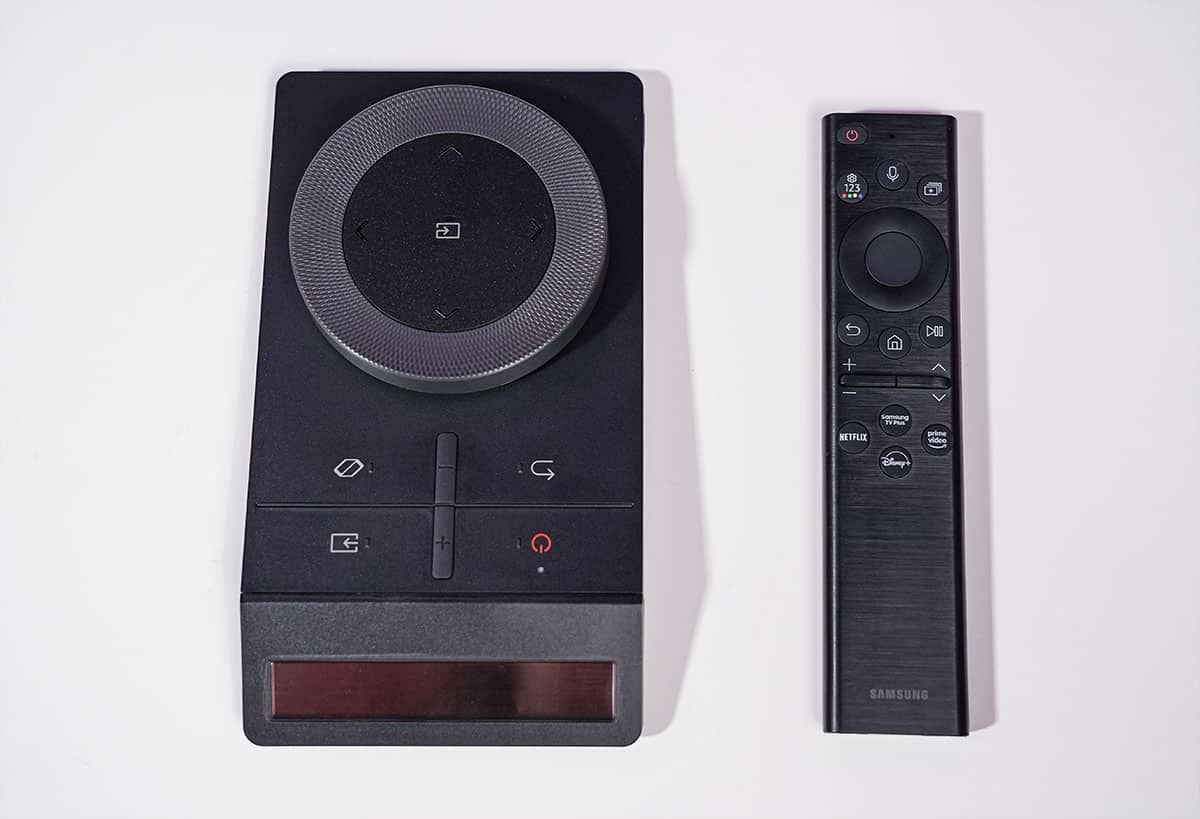
Use the dial to scroll through menus with ease. It also features directional buttons inside the dial to allow you to flick through menus in a more generic manner.
Samsung Ark Audible performance
One of the best features – in my eyes – that the Samsung Ark comes equipped with is its sound system. That’s right, I did call it a sound system and for good reason.
The Ark features four main speakers (located on each of the corners) alongside two powerful subwoofers found in the centre of the panel. All six speakers work together to create an incredibly powerful audible experience which offers excellent treble and bass.
Infact, the Ark is by far the loudest panel we’ve tested – offering up plenty of bass and depth in the mids. Additionally, the enhanced sound dome technology intelligently tailors the sound to your setting or viewing material – creating the perfect sound whether you’re gaming or watching a movie.
Color Accuracy & Picture Quality
We like to test every monitor we review for color reproduction to see how it would perform in color-sensitive situations. According to Samsung’s website, the Ark is rated for a wide color gamut (95% DCI-P3) which means both accuracy and HDR performance should be relatively decent.
Like always, we started off the color accuracy testing section of this review by loading up our colorimeter and running a test right out of the box.
Below are the results.
| Preset | White Point | Black Depth | Contrast Ratio | Average ΔE*00 | Gamma | Luminance |
|---|---|---|---|---|---|---|
| IDEAL | 6500K | 0.00cd/m² | Infinite | 0.00 | 2.2 | 120cd/m^2 |
| Graphic mode | 7110K | 0.0331 cd/m² | 3091:1 | 1.2 | 2.22 | 102.30cd/m2 |
| Entertainment mode | 7021K | 0.226 cd/m² | 2993:1 | 4.25 | 1.78 | 671.32cd/m2 |
| Game Mode | 6967K | 0.0292 cd/m² | 4057:1 | 2.87 | 2.05 | 129cd/m2 |
Out of the box, the Samsung Ark is set to a “graphic” color preset – meant for graphic designer or a more realistic color experience.
As you can see from the results above, the Samsung Ark featured a 7110K white point and low 0.03 cd/m2 black depth – fairly typical for VA panels. More impressive, however, was the 1.2 average delta right out of the box – a score you seldom come across from out of the box settings. Brightness was also set to a comfortable viewing level, coming in at 102 cd/m2. Gamma read 2.22.
We quickly moved onto the Entertainment mode and, as expected, the Ark became much less accurate. The entertainment mode is custom-designed for movies and TV shows, meaning colors have been enhanced to pop out of the screen. You can clearly see this when viewing the average deltaE score of the preset, which sat at a 4.25 average across a smaller spectrum of colors. Brightness was also increased exponentially, now sitting at 671cd/m2.
Lastly, we tested the Game mode to see how accurate it was. As you can imagine, like the entertainment mode, gaming mode wasn’t nearly as accurate as we’d like. That being said, when enabled, games do look fantastic and rich – just not as accurate as you might like.
We wasted no time and through the Ark through a like calibration to see how accurate it could become. At this stage, it’s worth touching on the fact that the Ark has a built-in calibrator that allows you to alter the color to your exact needs.
For best results, we left the sRGB values at 8/-2/1
| Preset | White Point | Black Depth | Contrast Ratio | Average ΔE*00 | Maximum ΔE*00 | Gamma |
|---|---|---|---|---|---|---|
| IDEAL | 6500K | 0.00cd/m² | Infinite | 0.00 | 0.00 | 2.2 |
| Calibrated Profile | 6579K | 0.0987 cd/m² | 3288:1 | 0.4 | 1.89 | 2.23 |
Using the calibration tool resulted in a large uplift in overall color accuracy. As you can see from the results above, white balance was much more realistic now, scoring 6579K. Black depth did increase slightly, but nothing overly problematic. Most impressive, however, was the 0.4 average deltaE which we now recorded – making the Ark a perfectly feasible option for editing video and images within the sRGB spectrum.
Panel Uniformity
Panel uniformity is a test we run to check how uniform the luminance and colors are across the entirety of the screen. During this test, the center square is used as the reference space. Every other square is then tested to see how far it differentiates from the reference.
In an ideal world, we want every square to be green, meaning it hasn’t broken the differential threshold – something we can set at the start of the test.
Note: results will differ from panel to panel.
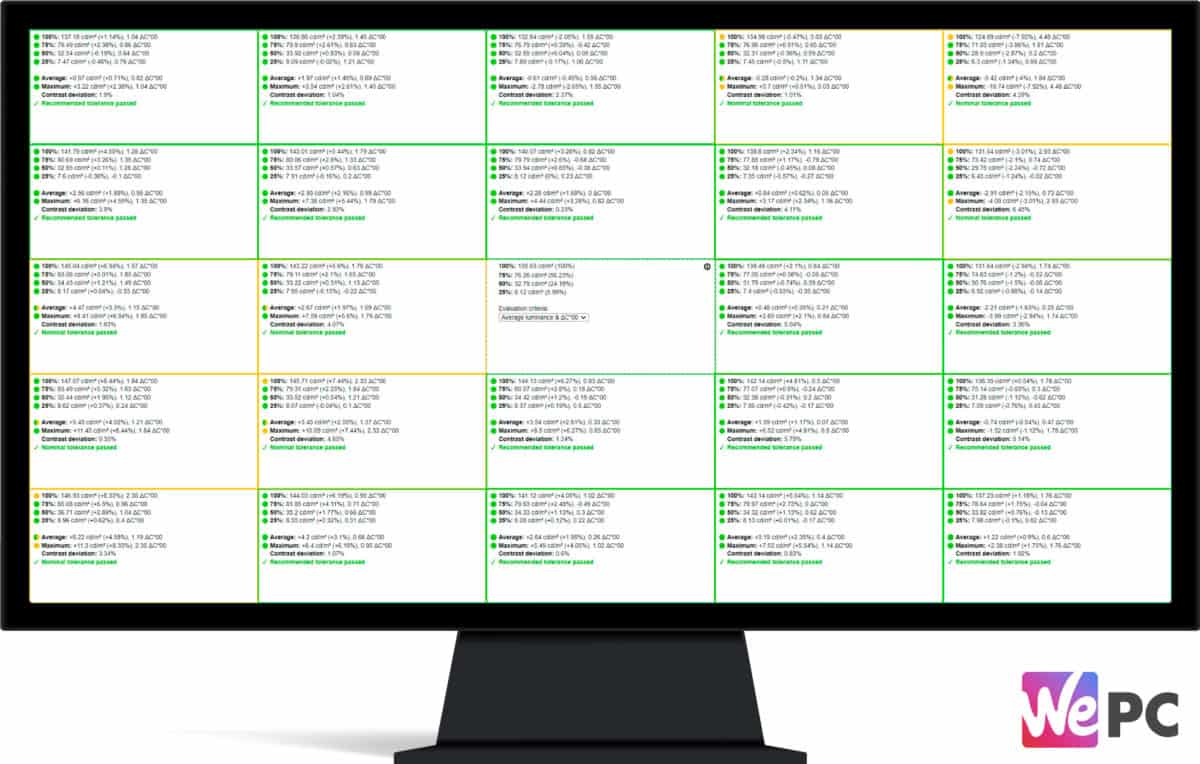
There was a small variance in the bottom left-hand corner of the monitor, however, that is to be expected from a VA curved panel.
Viewing Angles
Like most VA panels, the Samsung Odyssey Ark displayed pretty poor viewing angles overall. The viewing experience of the Ark was exceptional when facing it straight on, however, viewing it from over 40 degrees did result in some pretty aggressive color shift.
Color Gamut
DISCLAIMER: The test results below are based on initial findings and, on the surface, seem much lower than what is expected from the technology used in this panel.
We will continue to do color tests on the monitor until we’re satisfied with the results. We are also reaching out to Samsung to see whether the below results are expected.
As part of the calibration process, the DisplayCal will give an accurate measurement of the color gamut the monitor can provide. Below are the results of the color gamut test:
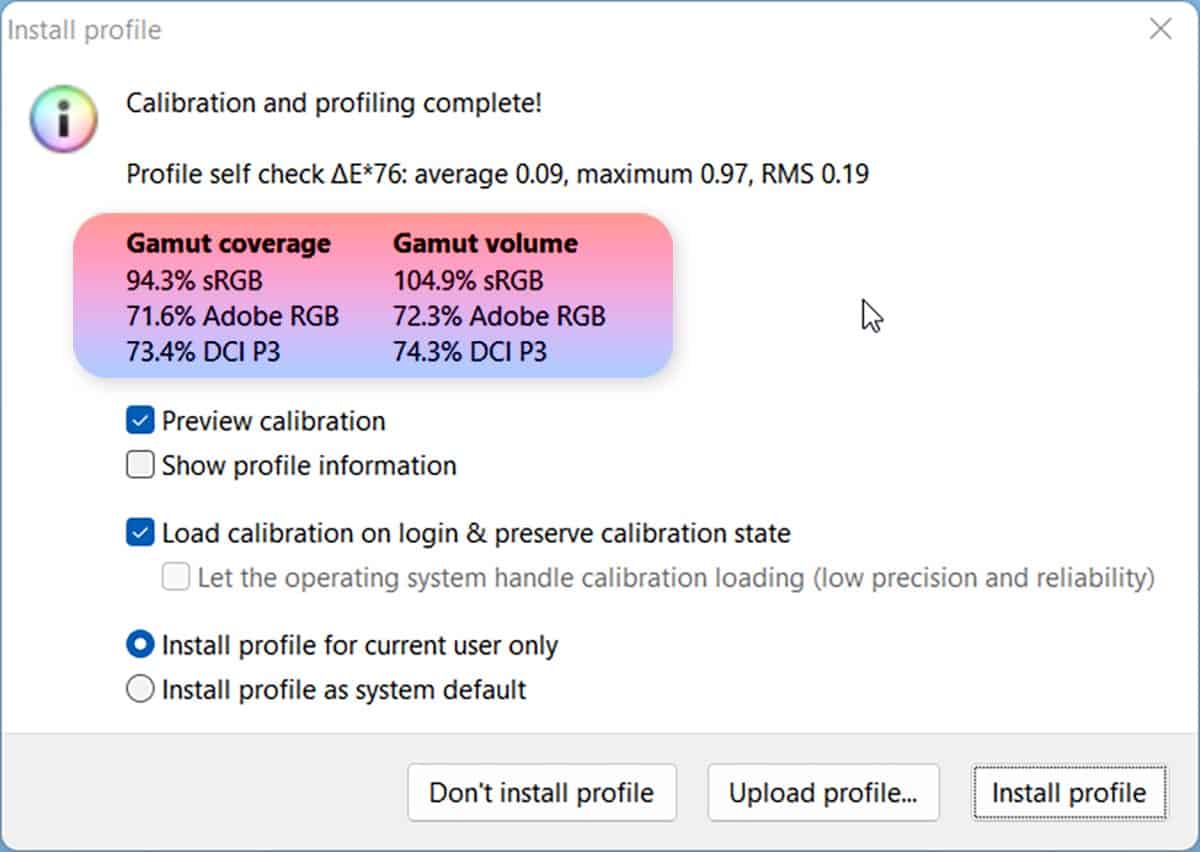
As you can see from the graph above, the Samsung Odyssey Ark didn’t quite live up to its 95% DCI-P3 color gamut. Instead, it produced a fairly lackluister 73.4% – far less than other monitors utilizing the same Mini LED Quantum backlight technology.
We recorded a 94.3% sRGB gamut coverage which, again, is far less than you might expect from this technology.
Above we’ve included the physical graphs for each color space, showcasing the exact coverage we recorded in the DCI-P3 and sRGB color spectrums.
Maximum And Minimum Brightness
We ended the color accuracy and picture quality testing by checking the maximum brightness, minimum brightness, and 120 candelas level on this panel. The results are below:
| Brightness | Candelas |
|---|---|
| 100 Brightness | 680.32cd/m2 |
| 0 Brightness | 75.26cd/m2 |
| 4 Brightness | 120 cd/m² |
Thanks to the technology used within the Samsung Ark, we were able to record almost 700 nits of peak brightness when in normal SDR mode.
This is one of the highest peak brightness results we’ve seen, producing an incredibly vibrant image.
Samsung Odyssey Ark gaming performance
With color accuracy and panel uniformity out of the way, it’s time to put the Samsung Odyssey Ark through a number of different gaming and response time tests to see how it stacks up in gaming scenarios. Like always, we’ll be testing the monitor across a variety of games to get a greater understanding of how this monitor performs overall.
For this portion of the testing, we enabled VRR and set the refresh rate to its max 165Hz.
On this occasion, we didn’t fire up CS:GO – not yet anyway – but instead enabled the monitor’s HDR to play some immersive-based single-player titles. Shadow of the Tomb Raider was the first game we played and boy did the Ark impress.
The 1000R curve was arguably the most important aspect of the panel, creating a tonne of immersion to the viewing experience. Better yet, sticking with Samsung’s recommended 80cm viewing distance, I never felt like I was looking at a curved image. Instead, it felt like I was viewing an enhanced version of the virtual world that kept wrapping around the periphery of my vision – a truly unique viewing experience.

Overall, the HDR performance of the display was good, however, comparing it to other high-performance HDR panels didn’t really result in a huge difference. This was a little disappointing when you consider the Samsung Ark is rated for 2000 nits of peak brightness in HDR.
That’s not to say the Ark didn’t produce a stunningly bright visual – because it did – it just wasn’t as dazzling as I thought it might be. Having said that, it still offered up a much more realistic and life-like color experience when compared to other gaming monitors that don’t feature high-end HDR.
Playing SOTTR was a very enjoyable and unique experience on the Samsung Ark. Its huge screen size paired with a 1000R curve and excellent colors really did provide an exceptional viewing experience.
We wasted no time and loaded up CS:GO to get a taste of just how responsive this 165Hz 1ms VA panel was. Playing CS:GO did produce a smooth, fluid gaming experience. Picture clarity and image sharpness of fast-moving images were quite impressive considering its massive size. Furthermore, with the Ark being a VA panel, you’d expect it to feature some visual artifacts such as ghosting and smearing – but that wasn’t the case.
Better yet, the Samsung Odyssey Ark features an image resizing tool (Flex Move Screen) that allows you to turn your 55-inch monitor into a smaller, more tailored size. Playing CS:GO was crazy on the 55-inch display, however, changing it to a more optimized 27-inch screen actually felt very playable. Furthermore, by resizing to a smaller screen, you aren’t burdened by ugly black bars. Samsung utilizes a firey embers background that feels much more premium.
Final Thoughts
So, there you have it, our comprehensive review of the Samsung Odyssey Ark – the world’s first 55-inch 1000R curved gaming monitor. Despite its geniune draw, the question still remains as to whether or not this is a feasible monitor for home use. And unfortunately, I don’t think it is.
Firstly, let’s start with the positives. The Samsung Ark is a super cool, futuristic looking monitor that increase the aesthetic prowess of any gaming setup out there. It’s wide scooping 1000R curve pairs nicely with the huge 55-inch display to create a starship vibe that is unlike anything on the market today.
Looks aside, the Ark also performs to a pretty high level as well. It offers a decent sRGB preset right out of the box for color accurate work, alongside decent fluidity when playing both single-player and more competitive titles.
Having said that, we can’t ignore the elephant in the room – and that’s the sheer size (and price) of this behemoth monitor. At 55-inches, it is simply too big for most people’s living space. Even in the WePC testing studio, the Ark was a real pain to maneuver from desk to desk.
Additionally, with a price tag that currently sits at around £2,500 ($3,500), it will far exceed most peoples budgets.
While this might be an incredibly cool gaming monitor, it certainly falls into the luxury showoff category – with only a few lucky individuals actually having the bank to justify its purchase.
Samsung Odyssey Ark gaming monitor



